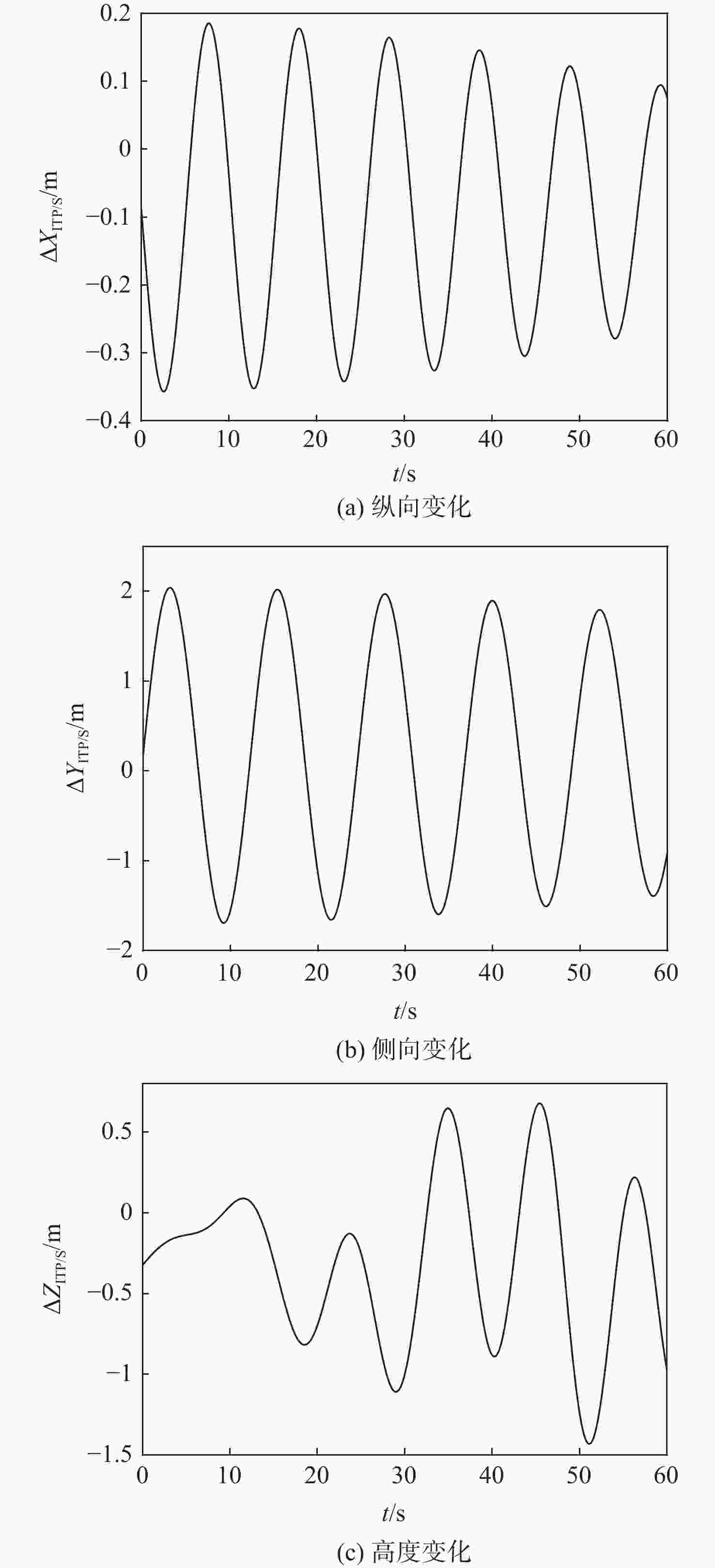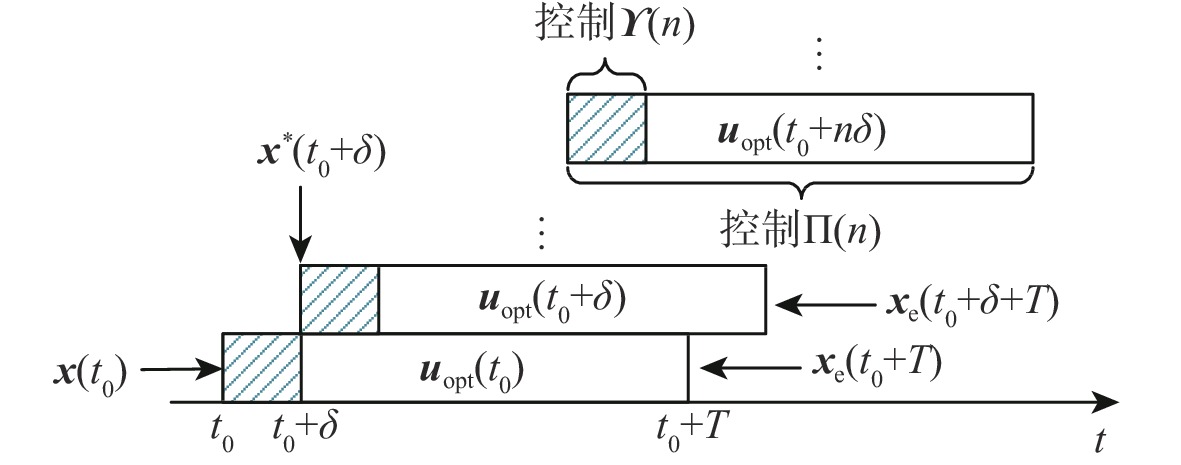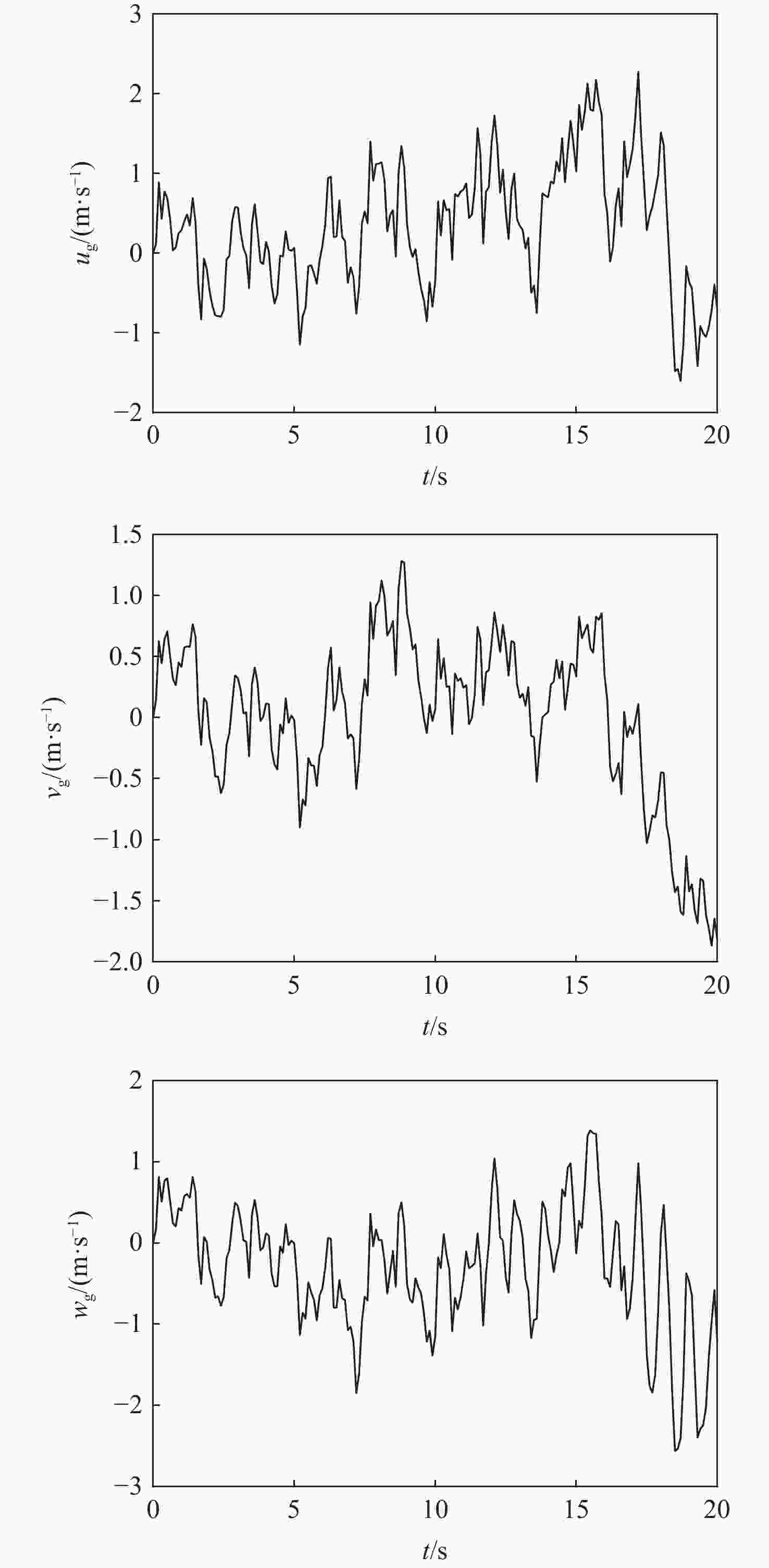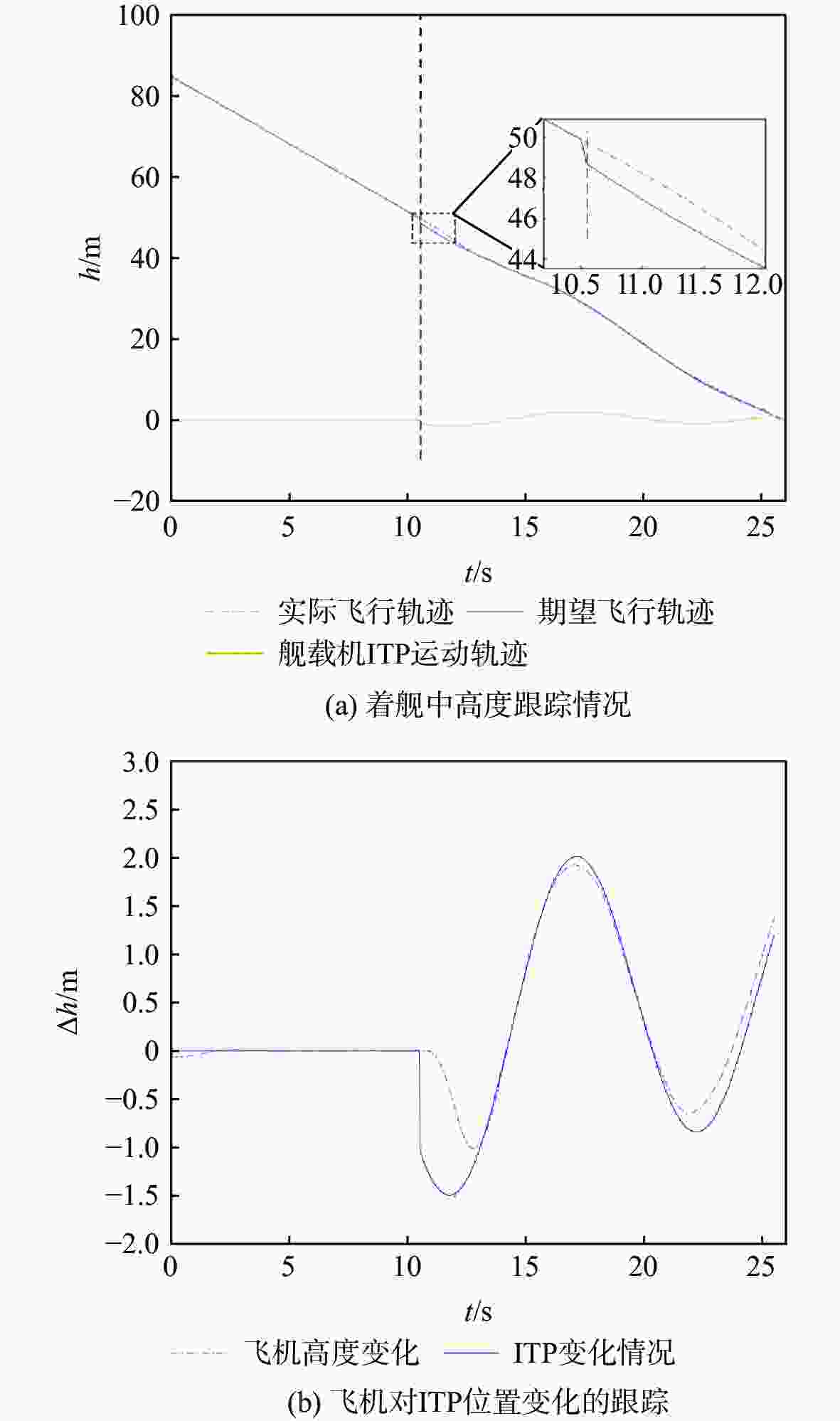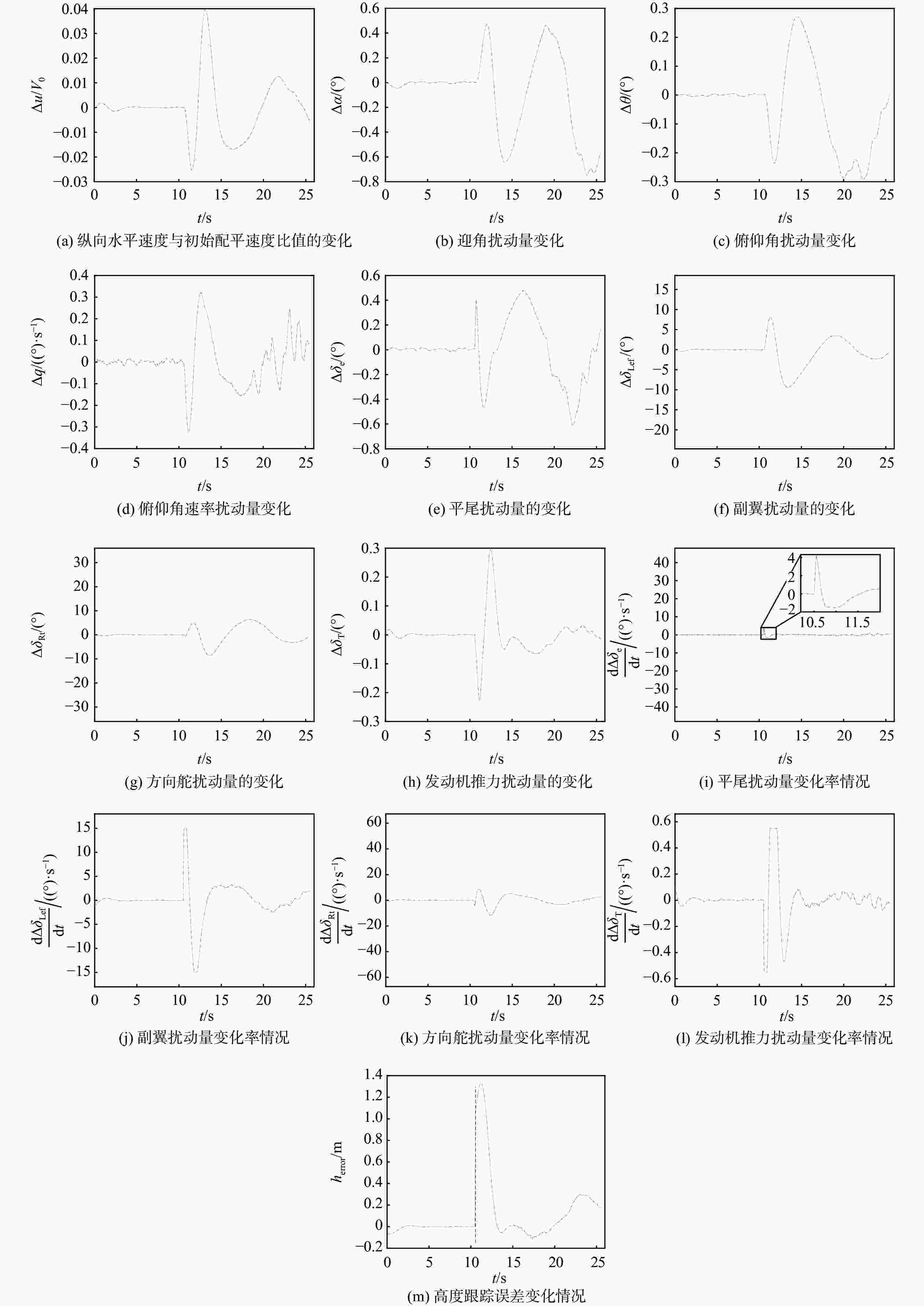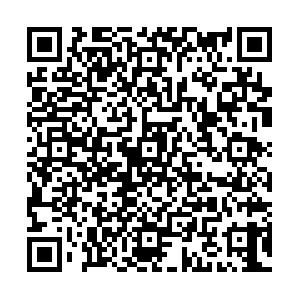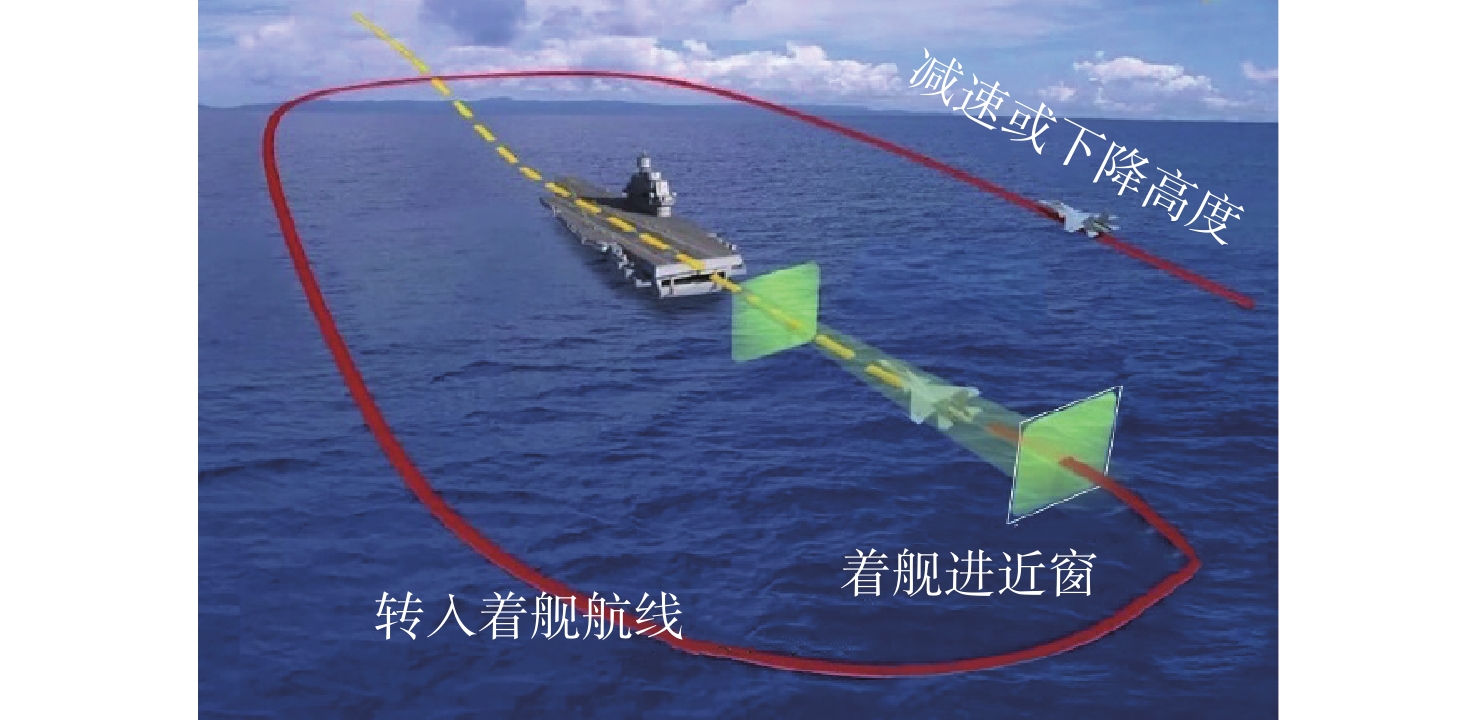-
摘要:
针对舰载机着舰过程中的航母运动、舰尾流扰动等影响,提出一种基于模型预测控制-线性二次型高斯(MPC-LQG)算法的精确着舰控制方法,开展飞机纵向通道的精确着舰控制研究。对飞机纵向动力学、舰尾流、航母运动、轨迹跟踪等,进行建模和分析。对MPC-LQG算法进行融合,以实现轨迹跟踪控制,核心思想是:模型预测控制进行航母运动补偿;设计全维状态观测,实现全状态反馈,以实现最优着舰控制。对不同的着舰情况和初始条件进行算法仿真,并与其他算法进行仿真比较。仿真结果表明,所提方法的轨迹跟踪效果很好,高度偏差0.1~0.2 m;相比传统着舰控制,所提方法动态响应快、着舰精度高。
-
关键词:
- 模型预测控制-线性二次型高斯 /
- 甲板运动 /
- 引导指令 /
- 着舰控制 /
- 轨迹跟踪
Abstract:This paper proposes a precise landing control method based on model predictive control-linear quadratic gaussian (MPC-LQG) to address the influences of carrier motion and wake turbulence during the landing process of carrier-based aircraft. The method is applied to research precise landing control in the longitudinal channel of the aircraft. The core idea of integrating model predictive control (MPC) with the linear quadratic gaussian (LQG) algorithm for trajectory tracking control is as follows: MPC is utilized for compensating the motion of the aircraft carrier; A full-dimensional state observer is designed to achieve full state feedback, thereby realizing optimal landing control. Finally, the simulation of the algorithm is carried out for a typical landing problem, and the landing control results with different initial conditions and algorithms are compared and analyzed. The simulation shows that the algorithm proposed has a good trajectory tracking effect, with the altitude deviation at ITP being 0.1~0.2m.
-
表 1 操纵量约束情况
Table 1. Constraints of carrier aircraft control system
控制变量 变量范围/(°) 配平值/(°) 速率范围/((゜)·s−1) $ {\delta _{\rm{e}}} $ [−24, 10.5] −11.9 40 $ {\delta _{{\rm{Lef}}}} $ [−3, 33] +17.6 15 $ {\delta _T} $ [0, 57.3] 14.6 32 -
[1] 甄子洋, 王新华, 江驹, 等. 舰载机自动着舰引导与控制研究进展[J]. 航空学报, 2017, 38(2): 020435.ZHEN Z Y, WANG X H, JIANG J, et al. Research progress in guidance and control of automatic carrier landing of carrier-based aircraft[J]. Acta Aeronautica et Astronautica Sinica, 2017, 38(2): 020435(in Chinese). [2] 段卓毅, 王伟, 耿建中, 等. 舰载机人工进场着舰精确轨迹控制技术[J]. 航空学报, 2019, 40(4): 622328.DUAN Z Y, WANG W, GENG J Z, et al. Precision trajectory manual control technologies for carrier-based aircraft approaching and landing[J]. Acta Aeronautica et Astronautica Sinica, 2019, 40(4): 622328(in Chinese). [3] 江驹, 王新华, 甄子洋, 等. 舰载机起飞着舰引导与控制[M]. 北京: 科学出版社, 2019.JIANG J, WANG X H, ZHEN Z Y, et al. Carrier aircraft takeoff and landing guidance and control[M]. Beijing: Science Press, 2019(in Chinese). [4] MENG Y, WANG W, HAN H, et al. A visual/inertial integrated landing guidance method for UAV landing on the ship[J]. Aerospace Science and Technology, 2019, 85(2): 474-80. [5] WILKINSON C, FINDLAY D, NICHOLS J, et al. Shipboard aircraft simulation with ship-relative navigation sensor modeling[C]//Proceedings of the 54th AIAA Aerospace Sciences Meeting. Reston: AIAA, 2016: 1769. [6] DING Z, LI K, MENG Y, et al. FLIR/INS/RA Integrated Landing Guidance for Landing on Aircraft Carrier[J]. International Journal of Advanced Robotic Systems, 2015, 12(5): 1-9. [7] SEDLMAIR N, THEIS J, THIELECKE F. Flight testing automatic landing control for unmanned aircraft including curved approaches[J]. Journal of Guidance, Control, and Dynamics, 2021, 11: 1-36. [8] GUAN Z, LIU H, ZHENG Z, et al. Moving path following with integrated direct lift control for carrier landing[J]. Aerospace Science and Technology, 2022, 120: 107247. doi: 10.1016/j.ast.2021.107247 [9] DENG Y, DUAN H. Control parameter design for automatic carrier landing system via pigeon-inspired optimization[J]. Nonlinear Dynamics, 2016, 85(1): 97-106. doi: 10.1007/s11071-016-2670-z [10] YANG Z, DUAN H, FAN Y, et al. Automatic carrier landing system multilayer parameter design based on cauchy mutation pigeon-inspired optimization[J]. Aerospace Science and Technology, 2018, 79: 518-530. doi: 10.1016/j.ast.2018.06.013 [11] ZHU Q, YANG Z. Design of air-wake rejection control for longitudinal automatic carrier landing cyber-physical system[J]. Computers & Electrical Engineering, 2020, 84: 106637. [12] WANG L, ZHANG Z, ZHU Q, et al. Longitudinal automatic carrier landing system guidance law using model predictive control with an additional landing risk term[J]. Proceedings of the Institution of Mechanical Engineers, 2019, 233(3): 1089-1105. doi: 10.1177/0954410017746432 [13] KOO S, KIM S, SUK J. Model predictive control for UAV automatic landing on moving carrier deck with heave motion[J]. IFAC, 2015, 48(5): 59-64. [14] 张杨, 吴文海, 汪杰, 等. 舰载无人机横侧向着舰控制律设计[J]. 航空学报, 2017, 38(S1): 721489.ZHANG Y, WU W H, WANG J. Design of carrier UAV lateral/ directional landing control law[J]. Acta Aeronautica et Astronautica Sinica, 2017, 38(S1): 721489(in Chinese). [15] 吴文海, 张杨, 胡云安, 等. 舰载机着舰非线性反演控制方法研究进展[J]. 系统工程与电子技术, 2018, 40(7): 1578-1587. doi: 10.3969/j.issn.1001-506X.2018.07.24WU W H, ZHANG Y, HU Y A, et al. Research development in nonlinear backstepping control method of carrier-based aircraft landing[J]. Systems Engineering and Electronics, 2018, 40(7): 1578-1587(in Chinese). doi: 10.3969/j.issn.1001-506X.2018.07.24 [16] SUBRAHMANYAM M B. H-infinity design of F/A-18A automatic carrier landing system[J]. Journal of Guidance, Control, and Dynamics, 1994, 17(1): 187-91. doi: 10.2514/3.21177 [17] HANSON C, SCHAEFER J, JOHNSON M. Design of low complexity model reference adaptive controllers[J]. NASA/TM, 2012, 215972. [18] LORENZETTI R C, NELSEN G L, JOHNSON R W. Direct lift control for approach and landing[J]. Journal of Aircraft, 1969, 6(3): 240-244. doi: 10.2514/3.44042 [19] NASTASI R, MARTORELLA P, HUFF R, et al. Carrier landing simulation results of precision flight path controllers in manual and automatic approach[C]//Proceedings of the 10th Atmospheric Flight Mechanics Conference. 1983: 2072. [20] DENHAM J W. Project MAGIC CARPET: Advanced Controls and Displays for Precision Carrier Landings[C]//Proceedings of the 54th AIAA Aerospace Sciences Meeting. Reston: AIAA, 2016, 1770. [21] 张志冰, 张秀林, 王家兴, 等. 一种基于多操纵面控制分配的IDLC人工着舰精确控制方法[J]. 航空学报, 2021, 42(8): 142-157. doi: 10.7527/S1000-6893.2021.25840ZHANG Z B, ZHANG X L, WANG J X, et al. An IDLC landing control method of carrier-based aircraft based on control allocation of multiple control surfaces[J]. Acta Aeronautica et Astronautica Sinica, 2021, 42(8): 142-157(in Chinese). doi: 10.7527/S1000-6893.2021.25840 [22] DURHAM W, BORDIGNON K, BECK R. Aircraft control allocation[M]. Chichester: John Wiley and Sons Ltd, 2016. [23] 高强, 谭述君, 钟万勰. 精细积分方法研究综述[J]. 中国科学:技术科学, 2016, 12: 5-16.GAO Q, TAN S J, ZHONG W X. A survey of the precise integration method[J]. Scientia Sinica Technologica, 2016, 12: 5-16(in Chinese). [24] STEVENS B, LEWIS F, JOHNSON E N. Aircraft control and simulation: Dynamics, controls design, and autonomous systems[M]. 3rh ed. Chichester: John Wiley and Sons Ltd, 2017. [25] Flying qualities of piloted aircraft:mil-std-1797. (Revision B Notice 1-Administrative)[S]. Washington D.C.: United States Department of Defense, 2012. [26] DURAND T S, WASICKO R J. Factors influencing glide path control in carrier landing[J]. Journal of Aircraft, 1971, 4(2): 146-158. -







 下载:
下载:


